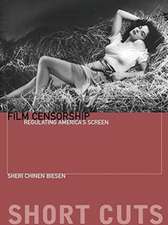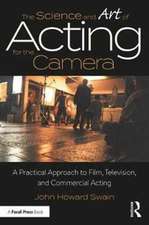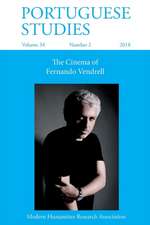Post-Production and the Invisible Revolution of Filmmaking: From the Silent Era to Synchronized Sound: Routledge Advances in Film Studies
Autor George Larkinen Limba Engleză Paperback – 30 sep 2020
Post-Production and the Invisible Revolution of Filmmaking studies the discourses surrounding post-production, as well as the aesthetic effects of its introduction during the 1920s and 1930s, by exploring the philosophies and issues faced by practitioners during this transitional, transformative period.
The introduction of post-production during the transition from silent cinema to the synchronized sound era in the 1920s American studio system resulted in what has been a previously unheralded and invisible revolution in filmmaking. Thereafter, a film no longer arose from a live and variable combination of audio and visual in the theater, as occurred during the silent film era, where each exhibition was a singular event. The new system of post-production effectively shifted control of a film’s final form from the theater to the editing room. With this new process, filmmakers could obtain and manipulate an array of audio elements and manufacture a permanent soundtrack. This transition made possible a product that could be easily mass-produced, serving both to transform and homogenize film presentation, fundamentally creating a new art form.
With detailed research and analysis and nearly 50 illustrations, this book is the ideal resource for students and researchers of film history and post-production.
| Toate formatele și edițiile | Preț | Express |
|---|---|---|
| Paperback (1) | 259.72 lei 6-8 săpt. | |
| Taylor & Francis – 30 sep 2020 | 259.72 lei 6-8 săpt. | |
| Hardback (1) | 1000.45 lei 6-8 săpt. | |
| Taylor & Francis – 13 dec 2018 | 1000.45 lei 6-8 săpt. |
Din seria Routledge Advances in Film Studies
-
 Preț: 310.85 lei
Preț: 310.85 lei -
 Preț: 310.65 lei
Preț: 310.65 lei -
 Preț: 310.14 lei
Preț: 310.14 lei -
 Preț: 304.12 lei
Preț: 304.12 lei -
 Preț: 313.47 lei
Preț: 313.47 lei -
 Preț: 301.92 lei
Preț: 301.92 lei -
 Preț: 349.00 lei
Preț: 349.00 lei -
 Preț: 364.89 lei
Preț: 364.89 lei - 9%
 Preț: 935.66 lei
Preț: 935.66 lei -
 Preț: 341.63 lei
Preț: 341.63 lei -
 Preț: 349.09 lei
Preț: 349.09 lei - 18%
 Preț: 1106.81 lei
Preț: 1106.81 lei -
 Preț: 416.06 lei
Preț: 416.06 lei - 18%
 Preț: 1116.02 lei
Preț: 1116.02 lei -
 Preț: 449.05 lei
Preț: 449.05 lei -
 Preț: 388.85 lei
Preț: 388.85 lei - 18%
 Preț: 1118.46 lei
Preț: 1118.46 lei - 18%
 Preț: 1112.34 lei
Preț: 1112.34 lei - 18%
 Preț: 1106.81 lei
Preț: 1106.81 lei - 18%
 Preț: 1106.85 lei
Preț: 1106.85 lei -
 Preț: 382.86 lei
Preț: 382.86 lei -
 Preț: 477.56 lei
Preț: 477.56 lei -
 Preț: 441.20 lei
Preț: 441.20 lei -
 Preț: 387.31 lei
Preț: 387.31 lei - 18%
 Preț: 729.62 lei
Preț: 729.62 lei - 18%
 Preț: 1056.95 lei
Preț: 1056.95 lei - 18%
 Preț: 1058.43 lei
Preț: 1058.43 lei - 18%
 Preț: 1161.62 lei
Preț: 1161.62 lei - 26%
 Preț: 848.54 lei
Preț: 848.54 lei - 18%
 Preț: 1109.99 lei
Preț: 1109.99 lei - 18%
 Preț: 1062.62 lei
Preț: 1062.62 lei -
 Preț: 398.82 lei
Preț: 398.82 lei - 18%
 Preț: 1117.43 lei
Preț: 1117.43 lei - 18%
 Preț: 1115.51 lei
Preț: 1115.51 lei - 18%
 Preț: 1114.30 lei
Preț: 1114.30 lei - 18%
 Preț: 1053.16 lei
Preț: 1053.16 lei - 18%
 Preț: 1057.75 lei
Preț: 1057.75 lei - 26%
 Preț: 819.90 lei
Preț: 819.90 lei - 18%
 Preț: 1112.34 lei
Preț: 1112.34 lei - 18%
 Preț: 1057.75 lei
Preț: 1057.75 lei
Preț: 259.72 lei
Preț vechi: 311.28 lei
-17% Nou
Puncte Express: 390
Preț estimativ în valută:
49.70€ • 51.35$ • 41.37£
49.70€ • 51.35$ • 41.37£
Carte tipărită la comandă
Livrare economică 26 martie-09 aprilie
Preluare comenzi: 021 569.72.76
Specificații
ISBN-13: 9780367663391
ISBN-10: 0367663392
Pagini: 238
Dimensiuni: 152 x 229 x 23 mm
Greutate: 0.44 kg
Ediția:1
Editura: Taylor & Francis
Colecția Routledge
Seria Routledge Advances in Film Studies
Locul publicării:Oxford, United Kingdom
ISBN-10: 0367663392
Pagini: 238
Dimensiuni: 152 x 229 x 23 mm
Greutate: 0.44 kg
Ediția:1
Editura: Taylor & Francis
Colecția Routledge
Seria Routledge Advances in Film Studies
Locul publicării:Oxford, United Kingdom
Public țintă
Postgraduate and UndergraduateCuprins
Introduction: Post-Production: An Invisible Art
Chapter One: The Invisible Revolution: the Art of Post-Production
Chapter Two: The Post-Production Process of Silent Film
Chapter Three: A Sense of Sound in the "Silent" Era
Chapter Four: Transition to Post-Production: The Rapid Rise and Fall of the Monitor Ma
Chapter Five: The Art and Science of Film Engineers
Chapter Six: Coverage and Post-Production
Chapter Seven: Post-Production: Past, Present, and Future
Coda: The Perpetual Revolution and Evolution
Chapter One: The Invisible Revolution: the Art of Post-Production
Chapter Two: The Post-Production Process of Silent Film
Chapter Three: A Sense of Sound in the "Silent" Era
Chapter Four: Transition to Post-Production: The Rapid Rise and Fall of the Monitor Ma
Chapter Five: The Art and Science of Film Engineers
Chapter Six: Coverage and Post-Production
Chapter Seven: Post-Production: Past, Present, and Future
Coda: The Perpetual Revolution and Evolution
Notă biografică
George Larkin is the Chair and an Associate Professor of Filmmaking at Woodbury University in Burbank, CA. He has a B.A. from Yale University, an M.A. in Shakespearean Studies from the University of Birmingham (England), and a Ph.D. in Film and Media Studies from the University of California, Berkeley.
Recenzii
"Beyond the existing canon of critical reception theory on Film Sound, Larkin’s work is a significant expansion of an emerging specialty: the history of the post-production of mainstream films and the art history which considers the collective authorship of soundtracks by industrial artisans." --David Stone, Professor of Sound Design, Savannah College of Art and Design (SCAD), Academy Award© winner for Best Sound Effects Editing, Bram Stoker’s Dracula (1992), and author of Hollywood Sound Design and Moviesound Newsletter: A Case Study of the End of the Analog Age. (2017, Focal Press)
"The evolution of sound from its inception in The Jazz Singer in 1927 to its present subliminal importance in film is clearly highlighted in this text. Larkin’s readable history of this on-going development contributes richly to the collaborative art of post-production." --John J. Michalczyk, Director, Film Studies Program, Boston College, USA
"The evolution of sound from its inception in The Jazz Singer in 1927 to its present subliminal importance in film is clearly highlighted in this text. Larkin’s readable history of this on-going development contributes richly to the collaborative art of post-production." --John J. Michalczyk, Director, Film Studies Program, Boston College, USA
Descriere
Post-Production and the Invisible Revolution of Filmmaking studies the discourses surrounding post-production, as well as the aesthetic effects of its introduction during the 1920s and 1930s, by exploring the philosophies and issues faced by practitioners during this transitional, transformative period.













